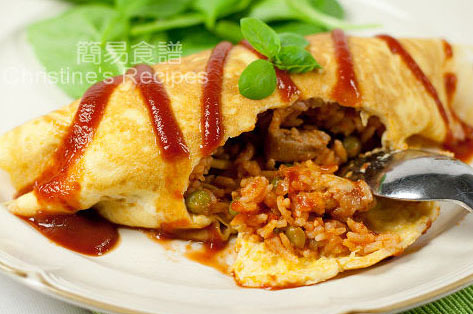現在位置 : 美食 > 日式料理 美食 / 蛋包飯, 關東煮 -- Japanese Rice Omelet, Oden
|
蛋包飯 (Japanese Omelet Rice)
蛋包飯 (日文:オムライス Omu-raisu)是在日本所發明的一種由蛋皮包裹炒飯而成的飯料理,英文又稱 Omurice, Omelette Rice。其日文名稱是由法文字 omelette (蛋包) 加上英文 rice (飯)所組成的日製新字。不論是在日本或台灣,都是相當受到歡迎的料理,不只是一道家庭料理,也有餐廳供應,甚至還有專賣店。 傳統的蛋包飯作法首先將打勻的蛋汁倒入平底鍋,煎成半熟的蛋皮時,再將炒飯倒入,炒飯一般是番茄醬雞肉炒飯,但也有其他變化,用蛋皮把炒飯給包起來。最後盛盤後,有不少店還會再淋上番茄醬。蛋包飯作法的挑戰是煎蛋皮,蛋皮要煎得好看又好吃,要掌握熱鍋冷油的訣竅,先開火將鍋子熱起來,再倒入冷冷的油,溫度對,煎出的蛋皮就會鬆軟膨香。 另一種作法是因為電影蒲公英而有名。在炒好的飯上放一個鬆軟的蛋包,然後在上桌後將其劃開,讓半熟的蛋包將炒飯蓋住。其他變化包括不用炒飯而用白飯,使用咖哩、demi-glace或牛腩汁等。 Omurice, sometimes spelled "omu-rice" (Omu-raisu), is an example of contemporary Japanese fusion cuisine (Yōshoku) consisting of an omelette made with fried rice and usually topped with ketchup. Omu and raisu being contractions of the words omelette and rice, the name is a wasei-eigo. It is a popular dish both commonly cooked at home and can be found at many western style diners and izakaya restaurants in Japan. It remained popular in Korea after Japanese occupation ended and it is a popular dish in many restaurants throughout South Korea today, where it is rendered as "오므라이스 (Oh-meu-rah-ee-seu)" in Hangul. The dish is also popular with children and often featured on okosama-ranchi or kids' meals. |
|
主廚教你做 - 蛋包飯
|
|
關東煮 (Oden)
關東煮 (御田/おでん oden),一説是「廣東煮」的訛音,「關東煮」、「關東炊」(関東煮、関東炊き)是關西人給這種料理的名稱。1997年中國大陸的日資便利店羅森(ローソン/Lawson)把おでん引入大陸,並稱其為「熬點」。通常材料包括煮雞蛋、蘿蔔、蒟蒻、竹輪等,這些材料都放在昆布或鰹魚湯裏煮。可用來佐飯,也可當作小吃來吃。 有說關東煮源自「味噌田樂 (yuè)」,那就是用水煮熟豆腐或蒟蒻,再用味噌(麪豉)調味後進食。 關東各地製作關東煮的方法會有所不同。不過跟一般的鍋料理不同,關東煮製作簡便,材料可以隨時放進湯裏煮。因此冬天的時候,這種料理尤其受歡迎。在日本,關東煮可以在便利商店或者路邊攤買來吃。 日本以外,關東煮在臺灣也十分流行,當地又被俗稱黑輪 (發音 olen),這是台語中代有齒音性質的邊音導致的類化; 實際上台灣的關東煮大部分已不是日本的原始口味,且在放置的材料也有相當差異性。近幾年關東煮在中國也比較風行,在路邊的便利店和飲食商業區內很容易就能買到,而口味與用料同樣與正宗的關東煮有較大變化。在中國的羅森所賣的關東煮當中,最受歡印的3款口味為貢丸、魚豆腐和蘭花豆腐乾。 Oden (おでん) is a Japanese winter dish consisting of several ingredients such as boiled eggs, daikon radish, konnyaku, and processed fish cakes stewed in a light, soy-flavoured dashi broth. Ingredients vary according to region and between each household. Karashi (Japanese mustard) is often used as a condiment. Oden was originally what is now commonly called misodengaku or simply dengaku; konnyaku or tofu was boiled and one ate them with miso. Later, instead of using miso, ingredients were cooked in dashi and oden became popular. Oden is often sold from food carts, and most Japanese convenience stores have simmering oden pots in winter. In Taiwan, the dish is called heilun (黑輪) in Mandarin or oolian in Taiwanese. Tianbula (甜不辣, "sweet, not spicy") is a similar dish commonly sold at night markets. Besides the more traditional ingredients, the Taiwanese oolian also uses many local ingredients, such as pork meatballs and blood puddings. More recently, oden is offered in convenience stores where it is sold as guāndōngzhǔ (關東煮 from Kansai word 関東煮). |
|
Open Rice 香港食肆餐廳指南 - 飲食資訊,搜索及排名。
|






